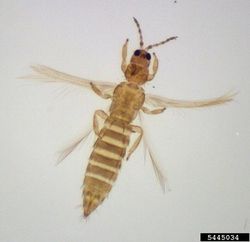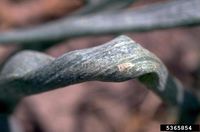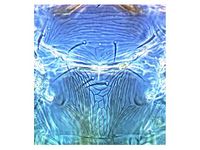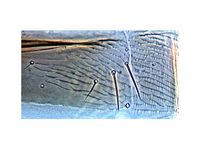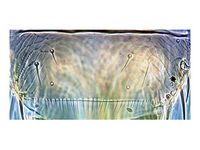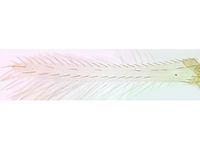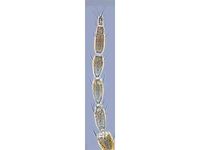Thrips tabaci
| Literature database |
|---|
| 473 articles sorted by: |
| • year (descending) |
| • research topics |
| • countries/regions |
| • host plants |
| • list of natural enemies |
Thrips tabaci Lindeman 1889 (onion thrips)
The thrips has a world-wide distribution and is highly polyphagous, attacking crops like onion, cabbage, potato, tomato and many others. Populations can increase dramatically under warm and dry conditions and yield losses of up to 50% have been estimated. Seedlings are particularly vulnerable to attacks. It penetrates the leaf surface and feeds on the plant sap. The thrips is also a vector of various important plant viruses like Iris yellow spot virus or Tomato spotted wilt virus. Dispersal is usually through the wind.
Damage symptoms include a silvery appearance of the leaf surface, deformations and necrosis. On onion, it feeds on the surface of the young leaves in the center of the onion neck, causing water loss and premature senescence of the leaves.
| Vernacular names | |
|---|---|
| • Deutsch: | Tabakthrips |
| • English: | onion thrips |
| • Español: | trips de la cebolla piojito negro de la cebolla |
| • Français: | thrips du tabac thrips de l'oignon |
| • Português: | tripes-da-cebola tripes-do-fumo |
For control, insecticides are commonly used, but pesticide resistance is often a problem. Frequent irrigation can reduce populations. Removal of weeds and volunteer crops can also help. Some cultivars have a certain level of resistance to this thrips.
The eggs are laid inside the leaf tissue. Male thrips are rare and reproduction is typically through the development of unfertilized eggs, a type of parthenogenesis called thelytoky. Such unfertilized eggs then develop into females. The life cycle from egg, through 2 larval stages and the non-feeding "prepua" and "pupa" stages, to mature adult lasts 3-4 weeks under favourable conditions. It overwinters in plant debris and in the soil. In temperate regions there may be 3-5 overlapping generations per year.
| Diagnostic features: | |
|---|---|
| • | antennae with 7 segments |
| • | pronotum without elongated anterior setae |
| • | pleurotergites with rows of fine microtrichia |
| • | ocelli gray (not red) pigmented |
| • | no setae originate within the triangular area of ocelli (but a pair outside that area) |
| • | body color variable according to temperature from yellow to brown |
The adult is about 1½ mm long and usually pale yellow to light brown. Darker forms might be present.
In the box at the right and the illustrations below, diagnostic features are listed and illustrated according to Riley et al. (2011).
For a review see Gill et al., 2015.
- Other images of Thrips tabaci (PaDIL and IPM Images - click to enlarge)
